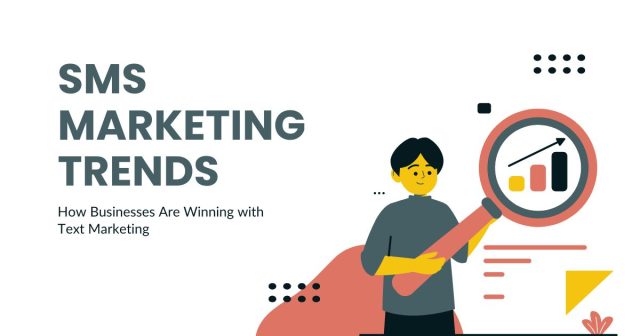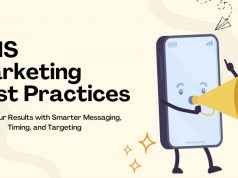SMS marketing in 2025 is more personalized, interactive, and data-driven, with AI, automation, and rich messaging leading the way. Brands that adapt will engage customers more effectively and stay competitive.
Text messaging has quietly become one of the most powerful channels in digital marketing. With open rates consistently above 90% and response times measured in minutes rather than hours, SMS marketing has proven its worth time and again. Yet many businesses still treat it as an afterthought—a mistake that could cost them dearly as competition intensifies.
The landscape of SMS marketing is shifting rapidly. New technologies, changing consumer expectations, and evolving privacy regulations are reshaping how businesses connect with customers through text messages. What worked in 2023 might feel outdated by mid-2025, making it crucial for marketers to stay ahead of emerging trends.
This comprehensive guide explores the most significant SMS marketing trends that will define 2025. From AI-powered personalization to interactive messaging experiences, these developments will determine which brands thrive and which fall behind in the mobile-first economy.
AI-Powered Personalization Takes Center Stage
Artificial intelligence is transforming SMS marketing from broad, one-size-fits-all campaigns into precisely targeted, personalized conversations. Advanced machine learning algorithms now analyze customer behavior patterns, purchase history, and engagement preferences to craft messages that feel genuinely relevant to each recipient.
Smart segmentation tools can identify micro-audiences within your customer base, enabling messages tailored to specific interests, shopping habits, or lifecycle stages. For example, a fitness brand might send workout motivation texts to active users while sharing recovery tips with customers who haven’t engaged recently.
Predictive analytics further enhances personalization by anticipating customer needs. E-commerce businesses are using AI to send restocking reminders just as customers run low on consumable products, or to recommend complementary items based on previous purchases. This proactive approach transforms SMS from reactive marketing into valuable customer service.

Interactive Messages Drive Engagement
Static text messages are giving way to interactive experiences that encourage immediate customer participation. Modern SMS platforms support rich media, quick reply buttons, and embedded links that create seamless user journeys without leaving the messaging app.
Quick polls and surveys embedded within SMS campaigns generate valuable customer insights while boosting engagement rates. Conversational commerce is another interactive trend gaining momentum. Customers can browse products, check inventory, and even complete purchases through text message exchanges powered by chatbot technology. For ideas on effective messages, check out our SMS marketing templates for conversions.
Conversational commerce is another interactive trend gaining momentum. Customers can browse products, check inventory, and even complete purchases through text message exchanges powered by chatbot technology. This friction-free shopping experience particularly appeals to younger demographics who prioritize convenience and speed.
Rich Communication Services (RCS) Revolutionizes Messaging
Rich Communication Services represents the evolution of traditional SMS, bringing app-like features to text messaging. RCS supports high-resolution images, videos, interactive buttons, and branded sender verification—capabilities that dramatically enhance the customer experience.
Brand verification through RCS builds trust by displaying company logos and names directly in message threads, reducing the risk of customers ignoring messages from unknown numbers. This visual branding creates consistency across digital touchpoints and reinforces brand recognition.
The expanded character limits and multimedia capabilities of RCS enable more creative campaign formats. Travel companies can send itinerary confirmations with embedded maps and weather updates, while fashion retailers share lookbooks with clickable product images. These rich media experiences drive higher engagement and conversion rates compared to standard text messages.
Brand verification through RCS builds trust and enhances engagement. Learn how RCS and SMS integration works to take advantage of rich messaging formats.

Privacy-First Messaging Strategies
Growing consumer awareness of data privacy is pushing SMS marketing toward more transparent, permission-based approaches. Customers increasingly expect clear value propositions before sharing their phone numbers, and they want easy opt-out mechanisms that actually work.
Double opt-in processes are becoming standard practice, requiring customers to confirm their subscription through a follow-up message. While this adds an extra step, it significantly improves list quality by ensuring genuinely interested recipients. Higher-quality subscriber lists lead to better engagement rates and fewer spam complaints.
Consumer awareness of data privacy is pushing SMS marketing toward more transparent, permission-based approaches. Double opt-in processes and consent management platforms help businesses ensure compliance with GDPR and CCPA. For building high-quality subscriber lists, explore our SMS marketing list building guide.
Integration with Omnichannel Experiences
SMS marketing is breaking free from its silo to become an integral part of comprehensive customer journey strategies. Modern campaigns seamlessly connect text messages with email, social media, and web experiences to create cohesive brand narratives.
Cross-channel triggering allows events in one channel to initiate SMS campaigns in another. An abandoned cart email that goes unread might trigger a follow-up text message with a limited-time discount. This coordinated approach ensures important messages reach customers through their preferred communication channels.
Customer service integration represents another significant trend. SMS platforms now sync with CRM systems and support ticketing tools, enabling customer service teams to continue conversations seamlessly across channels. A customer might start with a web chat, continue via SMS while mobile, and resolve the issue through a phone call—all tracked within a unified system.

Advanced Analytics and Attribution
Sophisticated analytics platforms provide deeper insights into SMS campaign performance beyond traditional open and click rates. Advanced attribution models track customer journeys across multiple touchpoints, revealing how text messages influence purchases that occur through other channels.
Real-time performance monitoring enables rapid campaign optimization. Marketers can adjust message timing, content, or targeting parameters based on early performance indicators, maximizing campaign effectiveness while minimizing wasted spend.
Cohort analysis helps identify the long-term value of SMS subscribers by tracking behavior patterns over extended periods. This data informs customer lifetime value calculations and helps justify SMS marketing investments to stakeholders focused on bottom-line results.
Automation and Trigger-Based Campaigns
Sophisticated automation workflows are replacing manual campaign management with intelligent, trigger-based messaging sequences. These automated systems respond to specific customer actions, behavioral patterns, or external events to deliver timely, relevant messages.
Lifecycle-based automation nurtures customers from initial awareness through repeat purchases. New subscribers might receive a welcome series that introduces brand values and popular products, while loyal customers get exclusive access to sales and new product launches.
Event-driven triggers extend beyond simple transactional messages to include seasonal campaigns, weather-based promotions, and location-specific offers. A coffee chain might send warming drink promotions when local temperatures drop, while a home improvement retailer promotes outdoor furniture when spring weather arrives.
The Rise of Hyperlocal and Context-Aware Messaging
As smartphones become even more tightly integrated with users’ daily lives, hyperlocal targeting is emerging as a groundbreaking trend in SMS marketing. Instead of relying solely on demographic or behavioral data, brands are now tapping into real-time contextual signals—such as location, time of day, weather conditions, or local events—to deliver messages that feel instantly relevant.
This shift is powered by advancements in geofencing and mobile device intelligence. Marketers can now trigger SMS messages when users enter or leave specific areas, such as retail stores, stadiums, airports, or event venues. For example, a retail chain might send an exclusive in-store discount as soon as a loyalty member steps inside a shopping mall. Restaurants can push lunchtime promotions to nearby office workers precisely when foot traffic peaks.
Context-aware messaging also enhances customer experience during travel and transportation. Airlines send gate-change notifications tailored to passengers’ airport locations, while ride-sharing services adjust promotional offers based on surge pricing periods. These timely, situational messages not only drive conversions but also deepen brand loyalty by providing true value at the moments that matter.
As consumers grow increasingly accustomed to personalized digital experiences, hyperlocal SMS campaigns become a natural extension of mobile-first behaviors. The brands that invest early in these capabilities will create a seamless bridge between physical and digital interactions—setting the benchmark for customer engagement in 2025 and beyond.
The Evolution of SMS in B2B Marketing

While SMS marketing has long been associated with B2C industries like retail, hospitality, and e-commerce, a major 2025 trend is its rapid adoption in the B2B sector. Business buyers are just as mobile-dependent as consumers, and SMS offers a direct communication channel that cuts through inbox clutter and accelerates decision-making.
B2B organizations are using SMS to streamline workflows, nurture prospects, and support complex buying journeys. Sales teams rely on automated text reminders to follow up on demos, confirm meetings, or share timely proposal updates. These messages maintain momentum in the sales pipeline and reduce the risk of leads going cold.
For account-based marketing (ABM), SMS serves as an ultra-personal touchpoint that complements email sequences, LinkedIn outreach, and sales calls. Personalized messages—such as invitations to exclusive webinars, early access to research reports, or VIP event passes—help strengthen relationships with high-value accounts.
Event organizers also leverage SMS to improve attendance and engagement during conferences, trade shows, and webinars. From registration confirmations to last-minute agenda changes, text updates ensure that attendees receive critical information instantly, improving overall event satisfaction.
As more B2B decision-makers prefer quick, mobile communication over lengthy email threads, SMS is becoming an indispensable tool for building trust, accelerating conversions, and enhancing the buyer experience.
SMS is rapidly expanding into B2B sectors. Sales teams use automated reminders, follow-ups, and personalized messaging to nurture leads. Account-based marketing campaigns benefit from SMS as a high-touch, direct communication channel. For B2B marketers, b2b email marketing open rates and conversions can provide valuable insights for integrating SMS.
The Growing Role of SMS in Loyalty and Retention Programs
In an era where customer acquisition costs continue to rise, brands are doubling down on retention—and SMS is quickly becoming a cornerstone of loyalty-building strategies. Instead of relying purely on promotional messages, businesses are embracing text messaging as a personalized engagement channel that nurtures long-term relationships.
Loyalty-based SMS campaigns often include reward reminders, tier-level updates, birthday discounts, and early access to special sales events. These timely messages encourage repeat purchases and reinforce customers’ sense of exclusivity. For example, beauty brands use SMS to notify VIP members about limited-edition product drops before the news hits social media.
Gamification is also gaining traction, with brands incorporating SMS challenges, points-earning opportunities, and surprise rewards to boost engagement. These playful, interactive experiences keep customers excited and connected between purchases.
Subscription-based businesses—from meal kits to fitness apps—use SMS to reduce churn by sending check-in texts, renewal reminders, and personalized “win-back” messages when customers show signs of disengagement. These proactive communications help maintain loyalty by addressing issues before they escalate.
In 2025, retention-focused SMS strategies will become even more sophisticated as brands integrate customer sentiment analysis and AI-powered churn prediction models. The result is a powerful, data-driven approach that treats SMS not just as a marketing channel, but as a relationship-builder.
Preparing Your SMS Strategy for 2025
The rapid evolution of SMS marketing requires businesses to audit their current strategies and identify areas for improvement. Start by evaluating your messaging platform’s capabilities and ensuring it supports emerging trends like RCS and interactive features.
Review your subscriber acquisition strategies to ensure they align with privacy-first principles. Consider implementing preference centers that give customers control over message frequency and content types. This approach builds trust while providing valuable data for segmentation.
Invest in training for your marketing team to ensure they understand new features and best practices. The most sophisticated technology won’t drive results if team members lack the skills to use it effectively.
Consider partnering with experienced SMS marketing agencies or consultants who specialize in emerging trends. Their expertise can accelerate your implementation timeline and help you avoid common pitfalls that waste budget and damage customer relationships.
The Future is Mobile, and Mobile is Messaging
SMS marketing has evolved far beyond simple promotional blasts to become a sophisticated, data-driven channel capable of delivering personalized experiences at scale. The trends outlined here represent fundamental shifts that will separate leading brands from those struggling to keep pace with customer expectations.
Success requires more than just adopting new technologies—it demands a strategic approach that prioritizes customer value, respects privacy, and integrates seamlessly with broader marketing efforts. Businesses that embrace these principles while staying current with technological advances will find that SMS marketing becomes an increasingly powerful driver of customer engagement and revenue growth.
The time to act is now. Start evaluating these trends against your current SMS marketing strategy and identify the opportunities that align best with your business goals and customer needs. The brands that move quickly and thoughtfully will establish competitive advantages that compound throughout 2025 and beyond.
Frequently Asked Questions (FAQ)
What industries benefit the most from SMS marketing?
While retail, e-commerce, and hospitality are traditional leaders, SMS is rapidly expanding into B2B, healthcare, financial services, education, and event marketing. Any industry that values real-time communication can benefit from SMS.
How is RCS different from regular SMS?
RCS enhances SMS with rich media, branded sender verification, interactive buttons, read receipts, and app-like experiences. It transforms simple text messages into visually engaging, high-conversion interactions.
Is SMS marketing compliant with privacy regulations?
Yes—as long as brands follow best practices. This includes obtaining explicit consent, using double opt-ins, providing clear opt-out options, and maintaining detailed consent records. New privacy tools make compliance easier than ever.
How often should businesses send SMS messages?
There’s no universal rule, but most brands find success with 2–6 messages per month. The key is to focus on relevance and value. Preference centers allow subscribers to choose message frequency, which improves satisfaction and reduces unsubscribes.
Can SMS marketing be automated?
Yes. Modern platforms support advanced automation workflows based on user behavior, lifecycle stages, past purchases, location data, and external triggers. Automation increases engagement while reducing manual workload.









